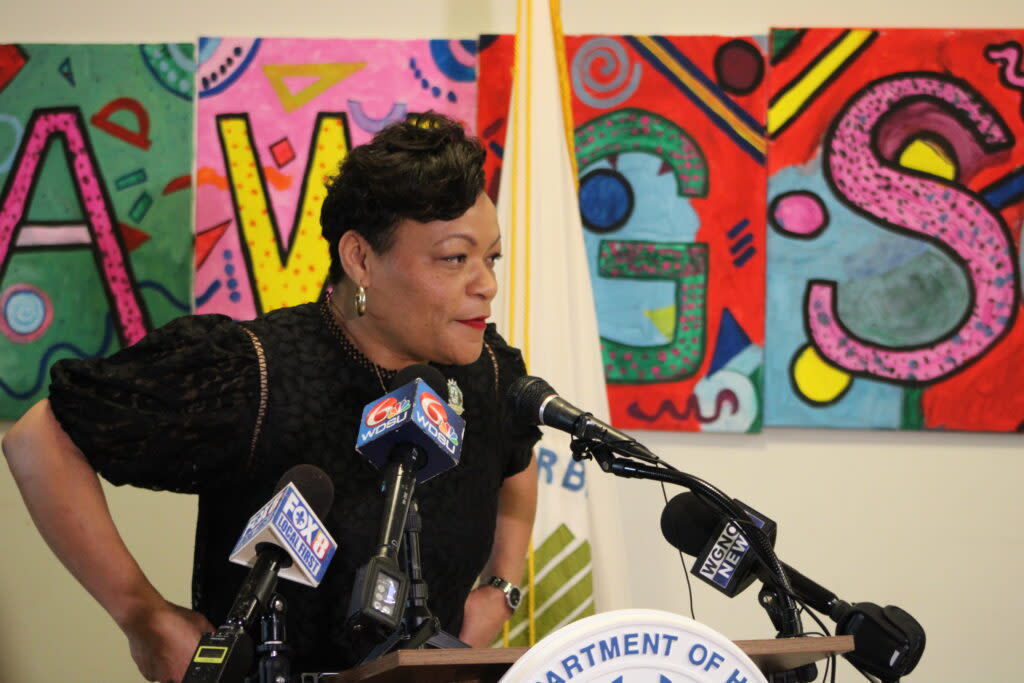Losing faith: Verite survey reveals structural causes of hopelessness in New Orleans

New Orleans Mayor LaToya Cantrell speaks to an audience at the Andrew P. Sanchez Multi-Service Center in the Lower 9th Ward on Feb. 16, 2023. She joined other officials to announce the end of the Road Home program. (Greg LaRose/Louisiana Illuminator)
A recent survey commissioned by Verite News showed high levels of resident dissatisfaction in New Orleans. This combined with evidence from the U.S. Census Bureau that the city is losing population at one of the highest rates in the U.S., creates a sense of hopelessness. This hopelessness remains despite many survey respondents stating how much they love the food and culture of the city.
To turn this pessimism around and build a better future, we must understand the structural causes of the challenges that residents currently face.
The first and overarching structural cause is lack of broad economic opportunities for all residents. Decades ago, while other Southern cities such as Atlanta and Houston were expanding into diversified corporate sectors, supplying both blue collar jobs for infrastructure construction and white collar jobs in corporate administration, New Orleans stayed locked into a tourism, hospitality and service economy. Entry-level jobs in those sectors tend to be low-paying and insufficient to build long term economic security.
In recent years, New Orleans has diversified and made progress in the entrepreneurial and high tech sectors. However, these jobs are usually for highly educated applicants with specific technical skills. The city still lacks an abundance of entry-level, good-paying jobs in blue collar fields such as construction.
With insurance rates and rents constantly increasing the cost of living, many residents choose to leave the city, seeking better jobs with better pay elsewhere.
The second cause of pessimism is crime, which is directly related to the first factor. There is a high correlation between concentrated poverty and crime rates. Low income neighborhoods tend to have higher crime rates than middle or high income neighborhoods. Long-term reduction in the crime rate will require a reduction in the poverty rate and an increase in job opportunities for the poor and working class.
The third cause of pessimism is that residents have lost faith in their institutions. Two of the most important institutions are the New Orleans Police Department, charged with keeping the city safe, and the Sewerage & Water Board, charged with keeping the city dry. The NOPD fared better than the S&WB in the survey, with 43% of respondents either somewhat or strongly approving of the job they do, and 41% somewhat or strongly disapproving. A whopping 71% of respondents somewhat or strongly disapprove of the Sewerage & Water Board’s job performance.
In a city that’s below sea level and vulnerable to hurricanes, it is disturbing that residents have such low confidence in the agency charged with protecting them from flooding. These opinions come from direct experiences of residents dealing with flood water in their streets and houses.
In terms of city government management in general, a clear majority at 56% did not believe that city agencies were spending their tax money wisely.
Finally, residents are pessimistic because they have lost faith in their elected leaders. The City Council received a mixed review with 45% of respondents approving and 34% disapproving. Mayor LaToya Cantrell is held in lower regard than the council, with a clear majority, 55% of respondents disapproving of her job performance, and only 33% approving.
While the mayor has hurt her own image by making poor personal decisions that caused public scandals, the primary cause of low approval ratings for any mayor is failure to deliver city services at the level expected by the residents.
And there are clear racial and income disparities among respondents. For the most part, white residents were more optimistic than Black residents and upper-income residents were more optimistic than middle or low-income residents.
The overall poverty rate in the city is 23%. However, Census Bureau American Community Survey data indicates that the poverty rate for white residents is only about 11%, one point lower than the national rate of 12%, while Black poverty is about 30%, more than double the national rate.
An unusually high Black poverty rate is a long-term defining characteristic of New Orleans and many of the city’s other problems are created or facilitated by this condition.
Until the elected leadership of the city figures out how to bring living-wage jobs to the city that specifically target residents living below the poverty line, all of the structural problems creating the sense of hopelessness for residents at every income level will remain. Future mayoral and City Council candidates should be challenged to offer specific plans of how they would accomplish this task.
This article first appeared on Verite News and is republished here under a Creative Commons license.

The post Losing faith: Verite survey reveals structural causes of hopelessness in New Orleans appeared first on Louisiana Illuminator.

